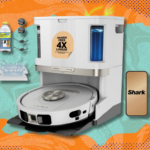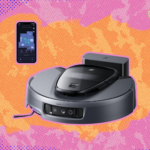
This Halloween, in the midst of Wordle-inspired costumes and general mayhem, something stood out to me: my friend Temujin carrying a point-and-shoot digital camera, the kind that dominated the 2000s before smartphone cameras took reign. He was using his mother’s camera, he explains, but he’s taken it for his own now. Throughout the night, we turned to the silver Canon IXUS 177, eliciting reactions that all sat on the plane of appreciation: « That’s such a good idea, » was the overwhelming consensus.
« All of my childhood memorabilia was taken on a digital and so they hold a real nostalgic principle to me, » Temujin, a fashion communications student, tells me. « Last year, I noticed the rise in people commemorating the digital camera across social media. »
The digital compact camera is indeed facing a distinctive revival, and not only because Instagram-savvy celebrities like Bella Hadid, Charlie D’Amelio, Nicola Peltz Beckham, and Emily Ratajkowski are engaging with this nostalgic device. As with most obsessions these days, TikTok is largely a force behind the revitalisation of the digicam.
Hundreds of videos and millions of views dedicated to the subject of digital cameras. On the app, the term « digital camera trend » has 137.3 million views; « vintage digital camera » has 177.3 million views while « cheap digital camera » has 26.5 million views. The hashtag #digitalcamera has 128.1 million and counting.
Videos under the subject document the use of these cameras and evidence the aesthetic value of the trend. TikTok user @haileyhuynhh posted a video of her pink Canon Powershot SD1200 writing in the caption, « i need to start taking more pictures on this omg ». Lifestyle influencer @mia.dson shared a video of the pictures she took on an old Sony digital camera. The account @digicamgirl_ is dedicated to « old digicams », where a range of vintage camera finds are posted; in one video, the user wrote, « this trend tho! ».

Others post « this is your sign to buy a cheap digital camera » videos, like user @ericamanzoli, who captioned her post « Digital>> » and shared a digital album of vacation pictures, complete with orange timestamps that unlock memories of another era in technology. Some videos help fellow TikTokkers find such cameras, noting eBay, Amazon, and other online marketplaces as key destinations, particularly for the pieces that are no longer being made. On eBay, it appears hardly any device exceeds $20, likely why TikTok champions such cameras as « cheap » and easy, while Amazon has slightly more expensive options that notably aren’t pre-owned. The aesthetic of these TikToks often mirror digital cameras themselves: grainy, muted, and cloaked in nostalgia.
Somewhere on the spectrum of analog, digital, and smartphone, digicams were lost in our collective cultural consciousness. In 2018, the compact digital camera garnered attention once again, with accounts like @digicam.love on Instagram shifting newfound focus on the camera. Still, the use of the digicam paled in comparison to the fascination with film and Polaroid cameras — which both millennials and Gen-Z would agree have been dominant in the last few years.
The digicam is just the latest in a line of « old » pieces of technology that are facing renewed interest at the hands of a generation fuelled by nostalgia. Gen-Z has been noted to bring back wired earphones — dismissing the rise of AirPods — the Tamagotchi, and flip phones. Technology, as an ever and rapidly-changing world, provides much to be nostalgic for: the trend-cycle is arguably too short and beloved products are abruptly replaced with updated versions, if not altogether discontinued. Our eagerness to cling onto and restore aesthetics, objects, and technology can therefore be seen as natural.
They also evoke a sense of simplicity: these cameras are intuitive and low-maintenance, without the endless possibilities of filters and edit tools.
This time is no different. The digicam is a facet of Y2K fashion, integral to the era of mini skirts, hot pink, and rhinestones. They also evoke a sense of simplicity: these cameras are intuitive and low-maintenance, without the endless possibilities of filters and edit tools. Photo dumps and 0.5 selfies are similar in their function: for social media to appear less curated and more faithful to the moment (ahem, BeReal). While digicams cater to this desire, they offer another layer to it, in that users have to take additional steps to upload their photographs online, instead of instantly posting through a smartphone camera. This pace of consuming media is far from what we experience today, but an approach Gen-Z increasingly seeks.
The irony is that TikTok, as a form of social media, and digital cameras could not be more different when it comes to their vibes. Arguably, they are at odds with one another. The Gen-Z mecca of dance videos and niche communities is worlds apart from that metallic piece of tech favoured by families on vacation. But the former is leading to the resurgence of the latter, as TikTok continues to platform sentimentality and spark affection for the past.
As some strive for authenticity, digital cameras may provide a pathway to accomplishing just that. On a night out or on holiday, the frame in front of you is exactly what you get, with the added benefit of a retro aesthetic. TikTok itself could never.




